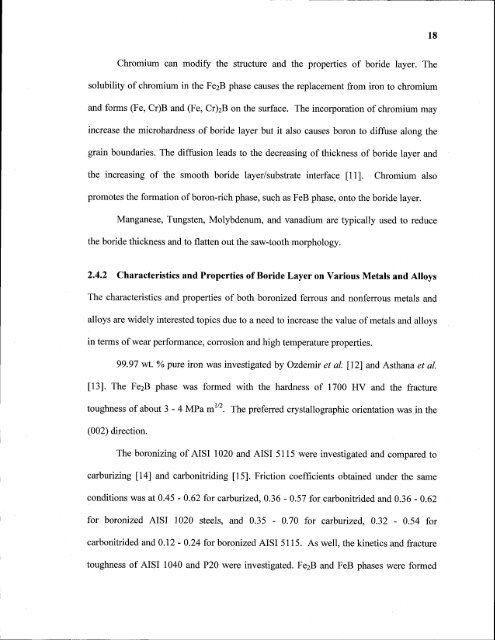Multi-component boron coatings on low carbon steel AISI 1018
Multi-component boron coatings on low carbon steel AISI 1018
Multi-component boron coatings on low carbon steel AISI 1018
Create successful ePaper yourself
Turn your PDF publications into a flip-book with our unique Google optimized e-Paper software.
18<br />
Chromium can modify the structure and the properties of boride layer. The<br />
solubility of chromium in the Fe2B phase causes the replacement from ir<strong>on</strong> to chromium<br />
and forms (Fe, Cr)B and (Fe, Cr)2B <strong>on</strong> the surface. The incorporati<strong>on</strong> of chromium may<br />
increase the microhardness of boride layer but it also causes <str<strong>on</strong>g>bor<strong>on</strong></str<strong>on</strong>g> to diffuse al<strong>on</strong>g the<br />
grain boundaries. The diffusi<strong>on</strong> leads to the decreasing of thickness of boride layer and<br />
the increasing of the smooth boride layer/substrate interface [11]. Chromium also<br />
promotes the formati<strong>on</strong> of <str<strong>on</strong>g>bor<strong>on</strong></str<strong>on</strong>g>-rich phase, such as FeB phase, <strong>on</strong>to the boride layer.<br />
Manganese, Tungsten, Molybdenum, and vanadium are typically used to reduce<br />
the boride thickness and to flatten out the saw-tooth morphology.<br />
2.4.2 Characteristics and Properties of Boride Layer <strong>on</strong> Various Metals and Alloys<br />
The characteristics and properties of both <str<strong>on</strong>g>bor<strong>on</strong></str<strong>on</strong>g>ized ferrous and n<strong>on</strong>ferrous metals and<br />
alloys are widely interested topics due to a need to increase the value of metals and alloys<br />
in terms of wear performance, corrosi<strong>on</strong> and high temperature properties.<br />
99.97 wt. % pure ir<strong>on</strong> was investigated by Ozdemir et al. [12] and Asthana et al.<br />
[13]. The Fe2B phase was formed with the hardness of 1700 HV and the fracture<br />
toughness of about 3 - 4 MPa m 1/2. The preferred crystallographic orientati<strong>on</strong> was in the<br />
(002) directi<strong>on</strong>.<br />
The <str<strong>on</strong>g>bor<strong>on</strong></str<strong>on</strong>g>izing of <strong>AISI</strong> 1020 and <strong>AISI</strong> 5115 were investigated and compared to<br />
carburizing [14] and carb<strong>on</strong>itriding [15]. Fricti<strong>on</strong> coefficients obtained under the same<br />
c<strong>on</strong>diti<strong>on</strong>s was at 0.45 - 0.62 for carburized, 0.36 - 0.57 for carb<strong>on</strong>itrided and 0.36 - 0.62<br />
for <str<strong>on</strong>g>bor<strong>on</strong></str<strong>on</strong>g>ized <strong>AISI</strong> I020 <strong>steel</strong>s, and 0.35 - 0.70 for carburized, 0.32 - 0.54 for<br />
carb<strong>on</strong>itrided and 0.12 - 0.24 for <str<strong>on</strong>g>bor<strong>on</strong></str<strong>on</strong>g>ized <strong>AISI</strong> 5115. As well, the kinetics and fracture<br />
toughness of <strong>AISI</strong> 1040 and P20 were investigated. Fe2B and FeB phases were formed
















